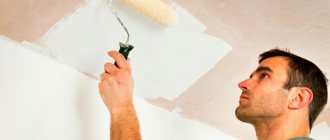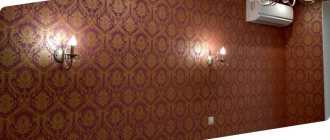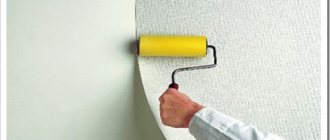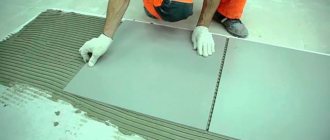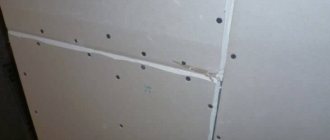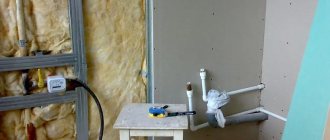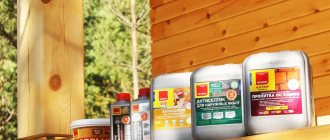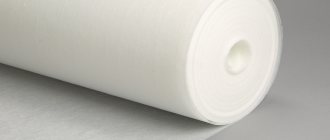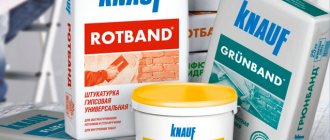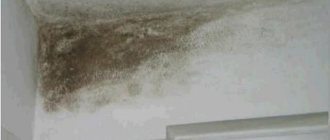Overview of the main features of the material
To understand the features of working with non-woven coating for painting, you need to understand what this material is and what criteria high-quality samples must meet.
Manufacturing technology
Non-woven paper for painting consists of the following main components:
- The basis is long-fiber cellulose - a durable and reliable material.
- The top layer is made of the finest polyester fibers, thanks to which the surface is so smooth and durable.
- The binding component is a polymer acrylic composition, which gives the coating a lot of positive properties: lack of linear expansion, resistance to humidity and temperature changes and a very long service life.
The surface of the coating resembles a drawing paper, but its structure is much smoother and softer. This coating is suitable for any room, it is completely environmentally friendly and does not emit any harmful substances during operation. That is why it can be used even in children's rooms, kitchens and bathrooms. .
Criterias of choice
High performance properties of this type of finish can only be guaranteed when the material is made from high-quality raw materials and in compliance with numerous standards.
It is quite simple to distinguish a high-quality product from a low-quality one:
- The main indicator of quality is a perfectly smooth, silky structure. Any extraneous inclusions, irregularities and other defects indicate that the product was manufactured in violation of technology. It is from the surface that you should start choosing the optimal option.
- Leading manufacturers pay great attention to the ideal processing of edges, since these are the most problematic areas - flaws and tears significantly worsen the appearance of the surface.
- Another indicator of high quality is the elasticity of the material; if there are traces of bending on it, it is better to choose another sample that is more resistant to damage.
- The composition should not contain any foreign additives. To ensure this, you need to ask the seller to provide a quality certificate. If it is not available, it is better to refuse the purchase, since all products in this group must undergo certification.
- Another important factor is the lack of stretch in any direction. It is very simple to check this; you need to pull any section of the material in different directions; if it is even slightly stretched, its strength is quite low.
Unlike fiberglass, construction non-woven fabric for painting is almost opaque; any visible fibers are a sign of low quality
Advice! It is best to choose products from well-known brands or read reviews about a particular material on construction forums on the Internet. As a rule, the necessary information can be found fairly quickly.
Painting the walls
The most painstaking way is to paint the walls without using paintable non-woven fabric /paintable wallpaper/fiberglass. The walls are rendered “in glass” - into a perfectly flat and smooth surface without scratches. This is achieved by repeatedly alternating layers of finishing putty (shitrok is the most popular now, which is where “shitrot” comes from) and sandpaper.
But this method is not particularly recommended for apartments in new buildings, because... the house is still shrinking and cracks may appear. Therefore, in such situations, use a base for paint , which can “hold” small cracks, hide scratches from sandpaper and hairline cracks, and there is no need to carefully paint the walls under it. Let's talk about this method.
1. Painting non-woven fabric Sold in large rolls one meter wide and about 25 long, smooth without texture. It comes in different densities, the smaller the thinner and lighter it is. The higher the density, the heavier it is (more difficult to stick), but the stronger it is. The fabrics are glued end-to-end using non-woven glue. After gluing it should be given enough time to dry before painting. Glue them end-to-end, it’s better to let them separate a little than to end up with a “croaker”; you can always fill the seam with putty. Then the steps: 1.1 in one layer, paint only the seams. 1.2 sew the seams over the paint, without getting into unpainted areas. We remove excess putty with a spatula, running along the seam without strong pressure. 1.3 we sand, removing the extra “bump” and smoothing. if necessary, repeat steps 1.2-1.3 again if after sanding you could feel the seam with your finger. 1.4 paint the walls two layers. And now for him all this rigmarole? So that not a single seam is visible at the finish and the walls look like “just painted walls” and not non-woven fabric. Paint is needed so that when sanding the interlining itself is not damaged and its texture is preserved, paint makes it stronger. But this is a method either for perfectionists (yes, yes, that’s exactly what I did) or for those who messed up when gluing non-woven fabric (and it’s easier to mess up with a dense one))) If there is no such desire and you want something simpler and faster, then after gluing and Once dry, you can prime and paint.
2. Fiberglass (“spider web”) It’s a rather unpleasant thing for your hands, so you don’t need to work with it unless you’re wearing gloves, otherwise you’ll end up with a lot of scratches later))) The thin one is glued end-to-end, after drying it’s scratched + sanded two circles and then primed- puts on makeup.
3. Paintable wallpaper. There are different textures and patterns. In general, they are no different from ordinary non-woven wallpaper, except that they can be painted in any color and subsequently repainted. Glue, prime and paint in 2 layers.
Tricks: , a good primer can also help . For example, BM has an acrylic primer “fresh start”. Slightly whitish and thick, can be tinted. Thanks to its texture, it fills scratches and smoothes out unevenness a little. After this, paint consumption is noticeably reduced.
2. For the second option, you can use the same glue for non-woven fabric as a primer. Surely it will remain! Dilute it a little with water and that’s it - the primer is ready
